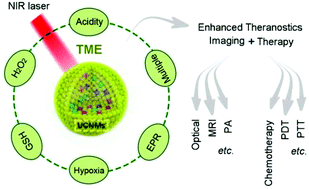Tumor self-responsive upconversion nanomedicines for theranostic applications
Abstract
To date, malignant tumors continue to be the most lethal disease, causing more than 8.2 million deaths worldwide each year. In recent years, nanostructures based on rare-earth upconversion luminescent nanoparticles have shown significant advantages in the integration of multimodal imaging and therapy. Compared with normal tissues, the tumor microenvironment (TME) exhibits unique characteristics including high interstitial fluid pressure, abnormal blood vessels, a hypoxic and slightly acidic environment, and high levels of glutathione (GSH) and hydrogen peroxide (H2O2). According to these characteristics, increasing attention in the antitumor field has been given to designing nanomedicines with specific responses to the TME based on rare-earth upconversion nanoparticles (UCNPs) and to achieving efficient tumor diagnosis and treatment under the premise of reducing side effects. Nevertheless, a review that systematically summarizes TME-responsive upconversion nanomedicines (UCNMs) for realizing tumor self-enhanced theranostics has not been published to date. In this review, we summarize the recent progress made in UCNP-based nanotherapeutics by highlighting the increasingly developing trend of TME-responsive UCNMs. The general characteristics of the TME are introduced in detail and their utilization in designing TME-responsive UCNMs is systematically discussed. Based on NIR light-excited optical imaging, we discuss the superiority of UCNMs when applied in tumor theranostics with an emphasis on how to use them to realize TME-mediated multimodal imaging-guided therapy.

- This article is part of the themed collection: Recent Review Articles


 Please wait while we load your content...
Please wait while we load your content...